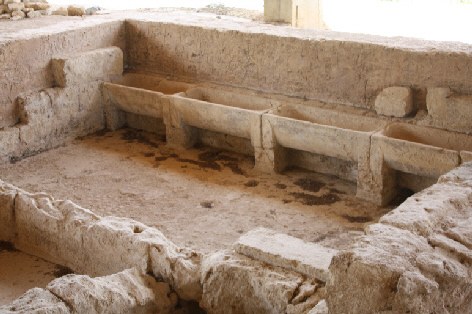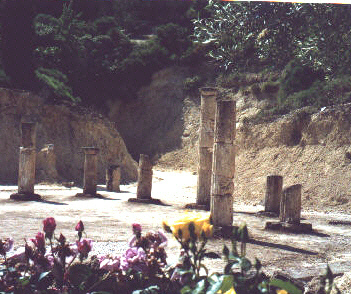Ancient Nemea
|
Journey through Ancient
Greece Ancient Nemea |
|
Ancient Nemea was not a city but, like Olympia, both a sanctuary to Zeus and a panhellenic games venue. As it has only recently been excavated (by Stephen Miller of Berkeley University, California) unlike Olympia the crowds haven't yet discovered it, and, it doesn't appear in Greek guides. There are no spectacular sculptures here as at Olympia and Delphi but this is one of my favourite sites with an excellent museum which really tries to help us understand the exhibits and the ruins. The setting is beautiful with many
trees, lawns and rose beds, and marble picnic tables.
Nemea is in a fertile valley and is becoming famous
nowadays as a wine producing area. |
| The Museum In the foyer are some interesting old pictures showing the sanctuary from 1766 through to the 19th century, including a sketch by Edward Lear. These illustrations show that although the capital on one of the columns looks very precarious it has not moved in hundreds of years, despite earthquakes in the area. In the main room the first thing to catch your attention is a huge window with a stunning view of the Sanctuary of Zeus and in front of the window a model of the site as it was in 300 BC. This makes it much easier to visualise. (the cypress trees you can see rather in the way were planted fairly recently to replicate the sacred grove of antiquity). To the right is a model of the stadium Don't miss: The tiny bronze figurine of Opheltes and the terracotta statuette of a baby boy holding a mask to his face, thought to be also Opheltes. llustrations and explanations of the ancient games- wrestling, boxing, jumping, running, discus and horse racing and the starting block from the stadium. Examples ofjumping weights (with an inscription), an iron discus (weighing 8.5 kg). The short video explaining the starting mechanismfor the races is well worth watching. Most of the information on ancient Nemea comes from the artefacts disposed of in wells, some of which are in on view,including the 6th century BC bronze hydria with a Kore head on the handle. In the courtyard are many pieces of column shafts, drums and capitals, sima (gutters) and so on from the oikoi and temple and a Doric capital from the bath house. |
 Bronze of Opheltes |
|
The Sanctuary
The
Temple of Zeus was constructed circa 330 BC on
the site of an earlier 6th century temple. It was built
mostly in limestone quarried locally,and covered with
white stucco to decorate and protect it. The temple
contains all three architectural 'orders'; an exterior
Doric peristyle and an interior Corinthian colonnade
round the naos, on top of which was a second story of
Ionic columns. The Doric columns were particularly
slender, more like Ionic ones (much taller and slimmer
than the ones we see in the temple of Apollo at Corinth.)
At the rear of the naos is a sunken crypt which had six
steps down into it of which three remain. The purpose of
this is not certain, it was possibly the site of a local
oracle. The cult statue was already missing when
Pausanius visited Nemea in the 2nd century AD. The
altar of Zeus was an unusually long and narrow
rectangle of limestone blocks. This was constructed in
the 5th century BC and was mentioned by Pindar. Next to
the temple was the Sacred Grove of cypress trees. New cypress
trees have been planted in the ancient planting
pits. |
 The Bath House |
| The Stadium
In a very good state of preservation here are the locker
room where athletes prepared for their events,
the tunnel through which they entered the stadium and the
stadium itself. The
locker room was rectangular with Doric columns on three
sides supporting a tiled roof and an open courtyard in
the centre. This was where the athletes oiled their
bodies The entrance to the tunnel is in the left hand corner of the locker room. It is one of the earliest true vaults in the Mediterranean (late 4th century BC). Look out for the ancient graffiti, where athletes waiting for their turn scratched their name (and sometimes added kallos, beautiful.) The stadium runs from south to north with the southern end built into the natural amphitheatre between the ridges of Evangelistra Hill. The track was 600 feet long (this was the unit of measurement called stadion.) Round the sides was a stone channel which brought fresh water for drinking and for wetting the track surface. We can see several 'settling basins'which may have been to collect dirt and/or for drinking from. Most of the 100 foot marker posts remain at the sides of the track. The races were run down the length and back, not round the edge as now, with the runners turning round a post at the end; one of these has been restored for the modern games. The judges, a panel of ten men from Argos who wore black in memory of the baby Opheltes, sat on a wooden platform on the side opposite the tunnel entrance The spectators sat on the banks on ledges roughly cut out of the soil; coins found at the site show that, as at a modern football match, the supporters from each city state sat together. The only stone seats are opposite viewing point 10. The only prizes were a palm branch and a fillet tied round the head for the winners and a crown of wild celery for all the athletes. The winner had a free meal every day for life from his home town.
|
 Locker Room
The Tunnel from the Stadium |
||||
|
|
for more information look at |